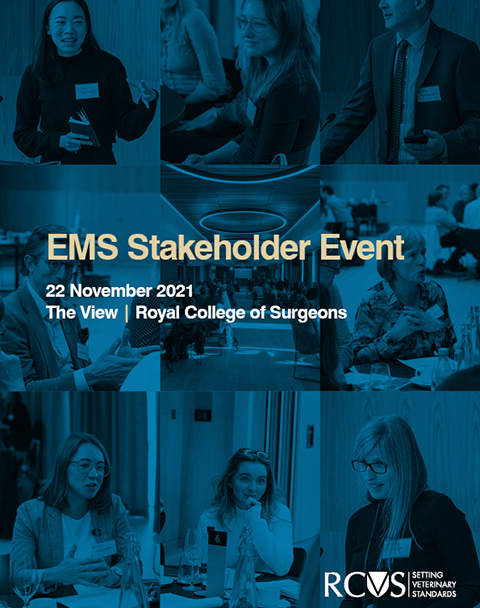New report outlines options for the future of student EMS
11 May 2022
We have published a report outlining the options discussed regarding future models of implementation for extra-mural studies (EMS), that came out of a stakeholder day held last November. Delegates at ‘The Future of EMS’ event included people from across all areas of the veterinary professions such as practising vets, students, new graduates, employers, vet schools and membership organisations. They were presented with the known benefits and challenges around implementing EMS – particularly around sustainability in the longer term – and then tasked with working in small groups to discuss different potential EMS models.
 Like many areas of veterinary work, EMS has been impacted by the coronavirus pandemic with the number of compulsory hours temporarily reduced and some forms of EMS amended. The negative impact of these changes, along with a known landscape of increasing student cohort sizes and demand on placements, were the catalysts for the organisation of the EMS event.
Like many areas of veterinary work, EMS has been impacted by the coronavirus pandemic with the number of compulsory hours temporarily reduced and some forms of EMS amended. The negative impact of these changes, along with a known landscape of increasing student cohort sizes and demand on placements, were the catalysts for the organisation of the EMS event.
Stakeholder evaluations and feedback from multiple sources over recent years have identified a number of challenges with the implementation of EMS placements including the consistency of the quality of the experience for students, the availability and cost of placements and instances of discrimination faced by students during placements. Throughout the event, stakeholders were asked to consider these challenges when discussing alternative models of EMS for the future. However, it was clear that despite the challenges with EMS, students often find placements to be a valuable element of their studies, helping them to gain invaluable experience, consolidate and apply their learning and gain a first-hand insight into working in professional settings. This was evidenced by a 2020 survey of students (pre-pandemic), which found that 75% of respondents were happy with the current levels of EMS.
The event aimed to be solutions-focussed with an eye on the longer-term future. Three potential models of EMS were put forward for delegates to discuss in addition to open sessions for ‘blue-sky thinking’. These were:
- Enhanced, learning-outcomes focused EMS placements that could potentially reduce the number of weeks of EMS needed – personal learning outcomes are co-created between students, tutors and practices with an advanced system of quality assurance introduced
- Additional structured placements co-ordinated by the school, further to intramural rotations, focusing on consolidating skills learned in the programme – with dedicated mentors that provide one-to-one support.
- Initiatives to increase the availability of EMS placements and the number of workplaces offering EMS – including improved recognition of the value and commitment EMS providers bring to the professions, raising awareness that mentoring counts as CPD, free access to RCVS resources such as VetGDP Adviser e-learning modules and the Knowledge library and incentives associated with the Practice Standards Scheme (PSS) for participating practices.
Dr Linda Prescott-Clements, RCVS Director of Education, said: “We are aware of the challenges that EMS places on students and providers and understand that, for many students, the placements can impact them financially. As well as addressing these issues, we also want to make sure that the implementation of EMS is sustainable in the longer term and continues to provide valuable experience for students. The EMS stakeholder event was an opportunity for people from across the veterinary professions to come together to discuss the benefits and issues with the current systems and put forward suggestions for what future models of EMS could look like.
“At the start of the event, we heard about the EMS experiences of four students, who outlined what they had learned and the positive aspects of their placement, as well as some of the difficulties they faced. Some of the key takeaway points were that the placements had provided a range of useful experiences, helped them to decide if they wanted to work in a particular area of veterinary work and helped them to make connections at practices for the future.
“We know that for so many students, EMS is an integral part of their veterinary school experience and, as a result of the discussions at the event, and further consideration within RCVS Education Committees, we will soon have proposals for future models of EMS to share with the profession in the form of an action plan. We are pleased that the options put forward by the BVA recently are aligned with the options discussed at the RCVS stakeholder event, and we look forward to continuing to liaise with key stakeholders, including representative groups, students, vet schools and employers.”
The next steps from the EMS event are to take the outcomes from the day and write them up into viable proposals and action plans to be presented to the RCVS Education Committee later this month.
A report of the EMS stakeholder event can be viewed here: www.rcvs.org.uk/EMSday-report